Toyota Land Cruiser 200 Series vs Y62 Nissan Patrol 2020 review: GXL and Ti-L towing comparison

Value
Note: this is a vehicle match-up based on price, not a comparison between vehicles of a similar specification.
The LandCruiser 200 Series GXL,$96,240.
The Nissan Patrol Ti-L $93,959
- Compared to the Patrol, the GXL’s interior is a bit more basic.
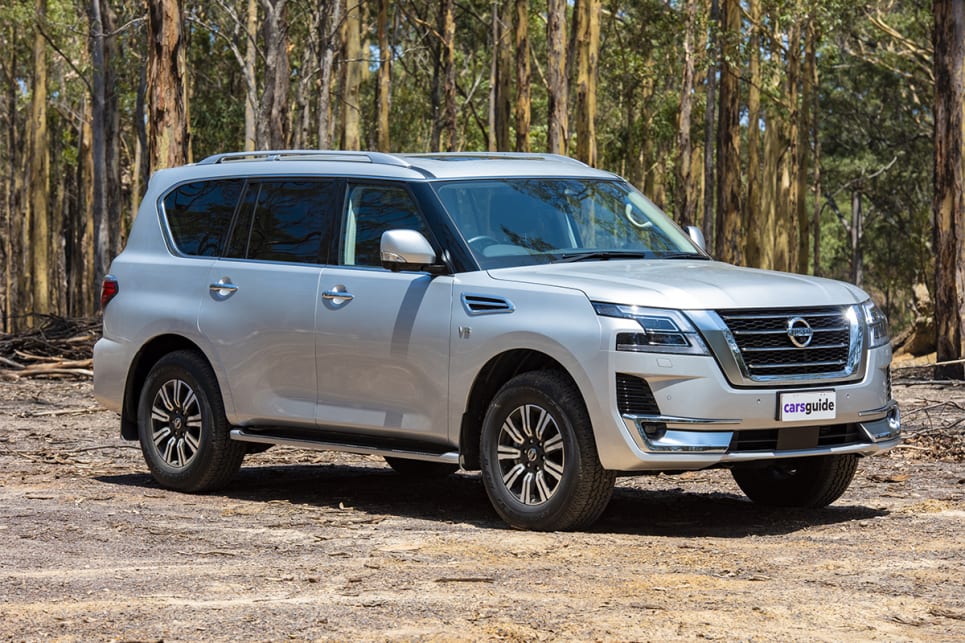 The Nissan Patrol Ti-L is the top-spec Patrol in a two-variant range.
The Nissan Patrol Ti-L is the top-spec Patrol in a two-variant range.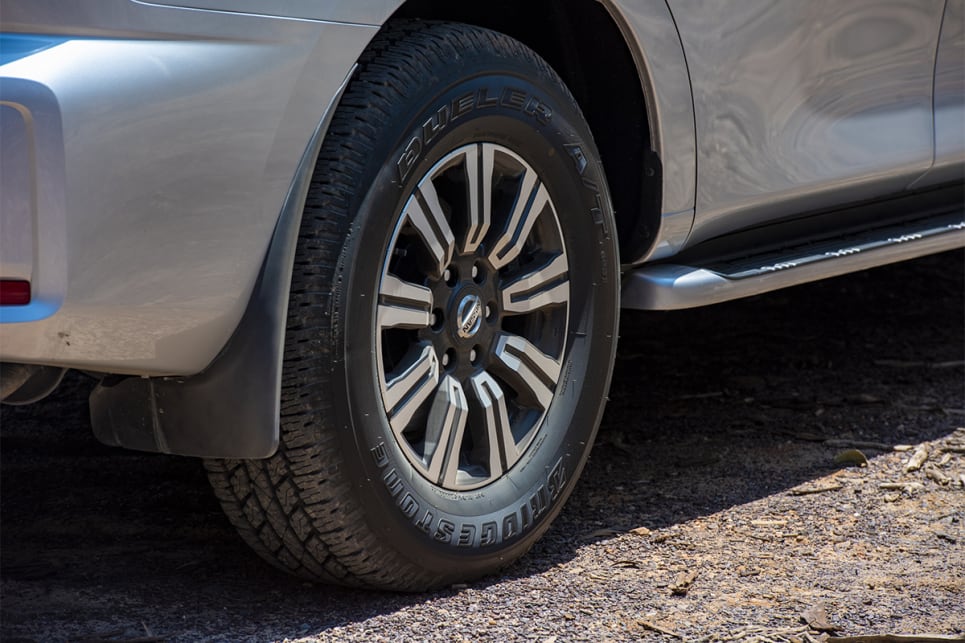 The Ti-L Patrol scores 18-inch alloy wheels.
The Ti-L Patrol scores 18-inch alloy wheels.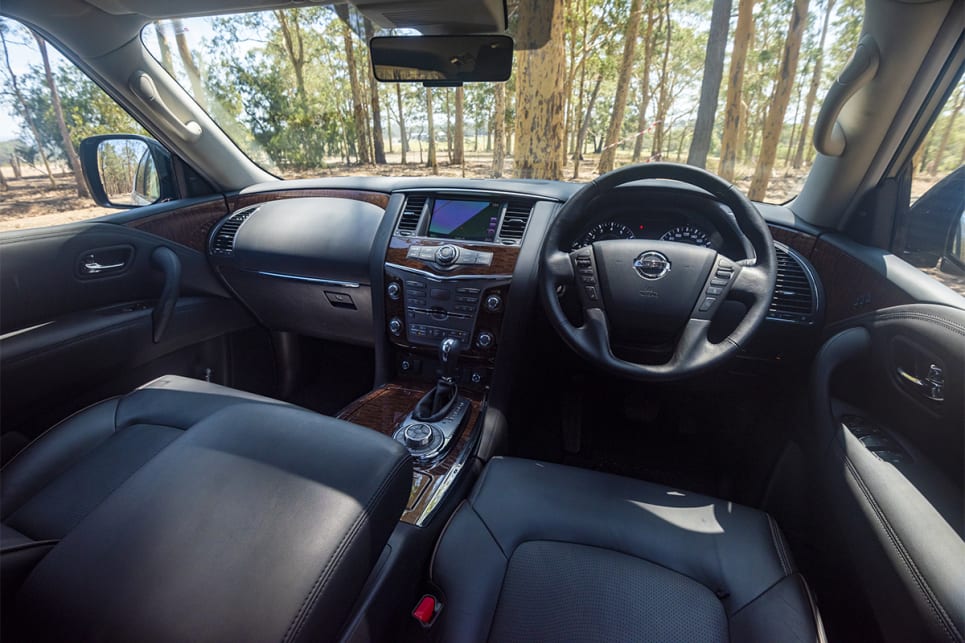 The Patrol, with woodgrain and soft-touch surfaces galore, is well appointed and feels quite luxurious inside.
The Patrol, with woodgrain and soft-touch surfaces galore, is well appointed and feels quite luxurious inside.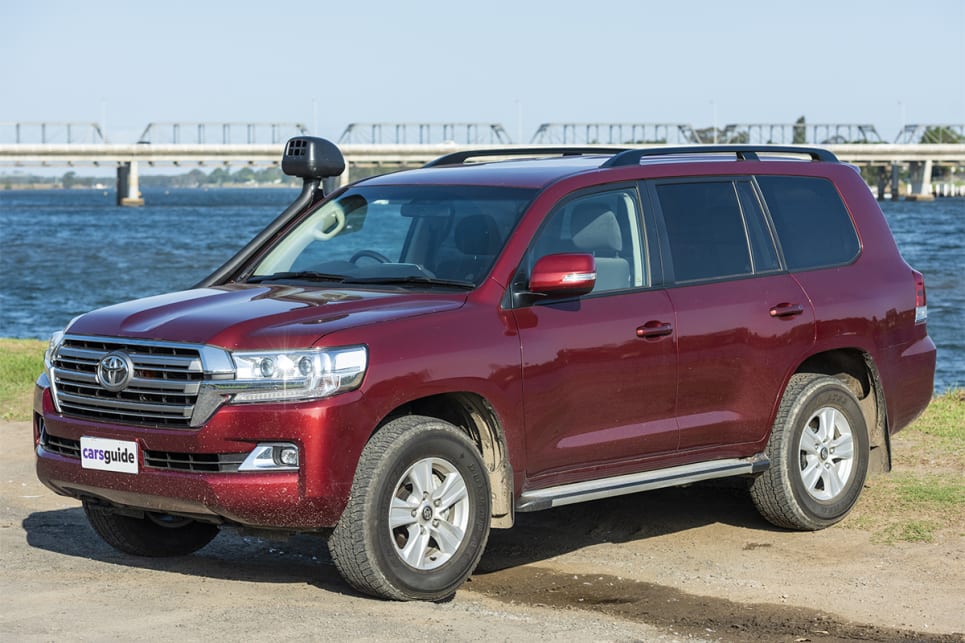 The LandCruiser 200 Series GXL has a list price of $91,890 (plus on-road costs).
The LandCruiser 200 Series GXL has a list price of $91,890 (plus on-road costs).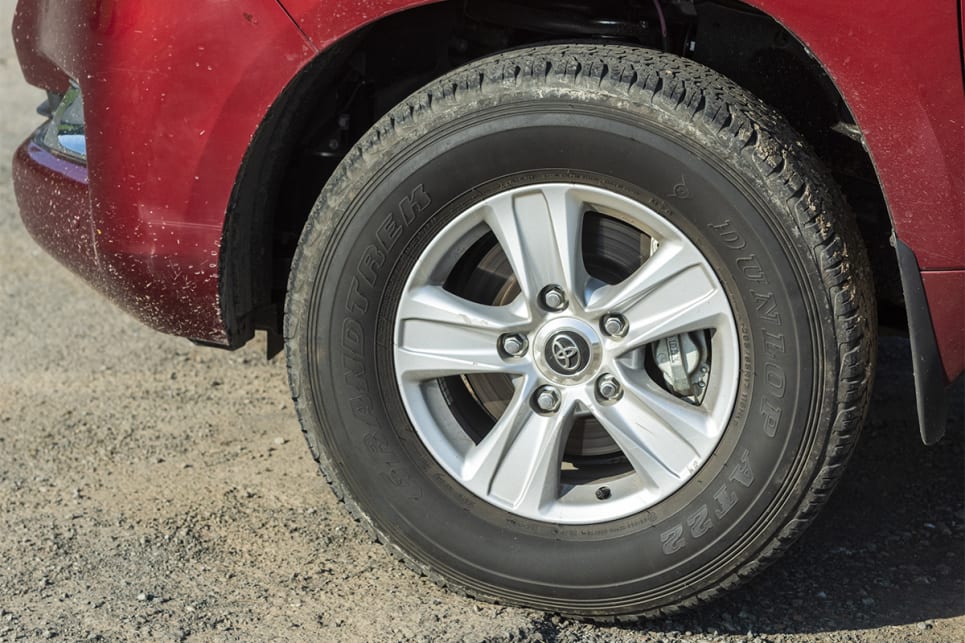 The GXL wears 17-inch alloy wheels.
The GXL wears 17-inch alloy wheels.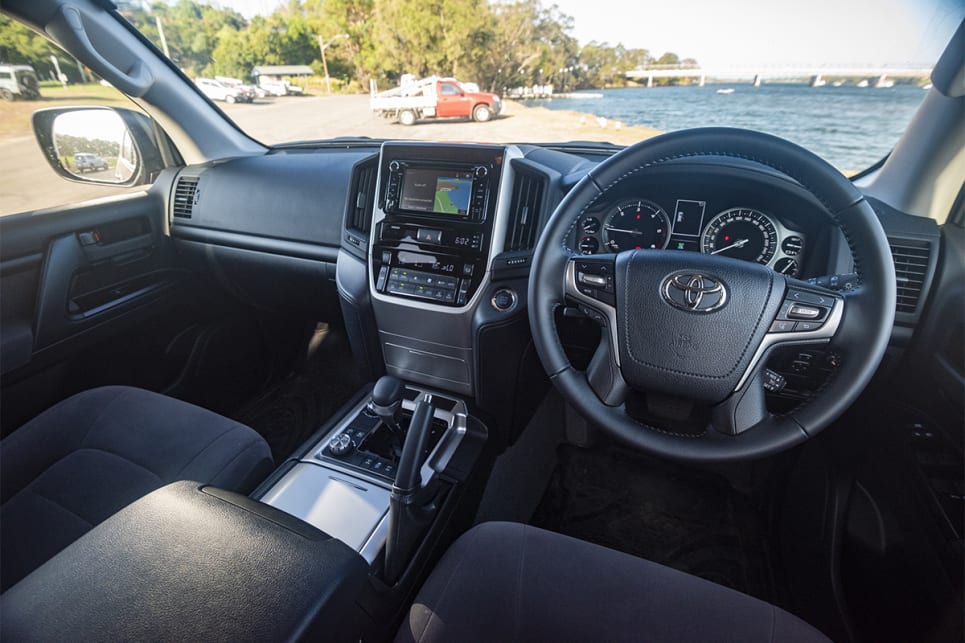 Compared to the Patrol, the GXL’s interior is a bit more basic.
Compared to the Patrol, the GXL’s interior is a bit more basic. The Nissan Patrol Ti-L is the top-spec Patrol in a two-variant range.
The Nissan Patrol Ti-L is the top-spec Patrol in a two-variant range.
Safety
Check out the table below.
| Toyota LandCruiser 200 Series GXL 4×4 | Nissan Patrol Ti-L 4×4 | |
| Auto emergency braking (AEB) | No | Yes |
| Blind spot monitoring | No | Yes |
| Rear cross traffic alert | No | Yes |
| Lane departure warning | No | Yes |
| Lane keep assist | No | Yes |
| ESC | Yes | Yes |
| Reversing camera | Yes | Yes |
| Rear parking sensors | Yes | Yes |
| Front parking sensors | Yes | Yes |
| Airbags | Eight | Eight |
Engine and transmission
The 200 Series has a 4.5-liter twin turbo-diesel V8 – producing 200kW at 3600rpm and a load-dragging 650Nm between 1600-2600rpm – and a six-speed automatic transmission.
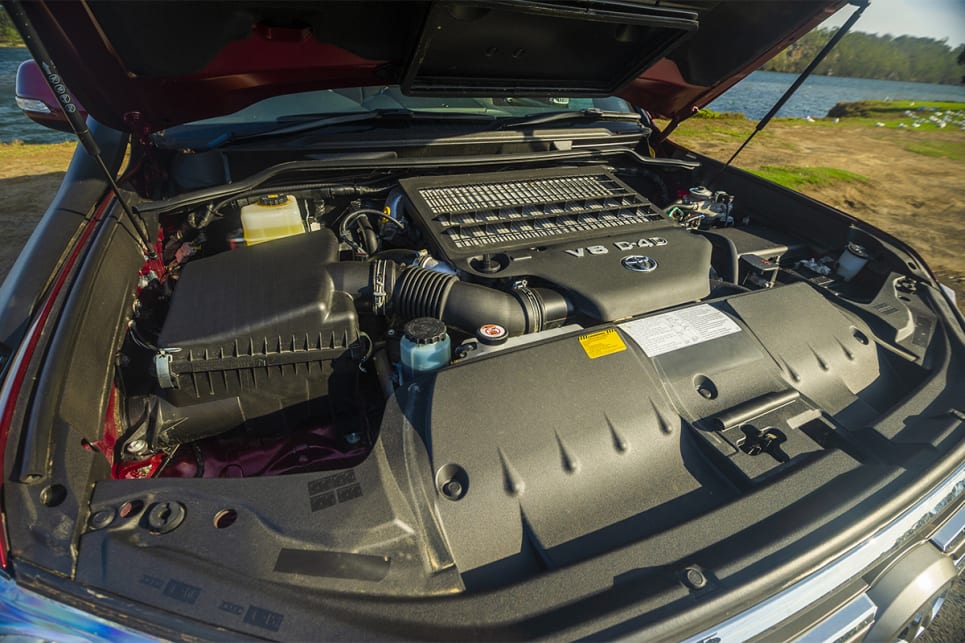 2020 Nissan Patrol/Toyota LandCruiser | engine gallery | Marcus Craft
2020 Nissan Patrol/Toyota LandCruiser | engine gallery | Marcus Craft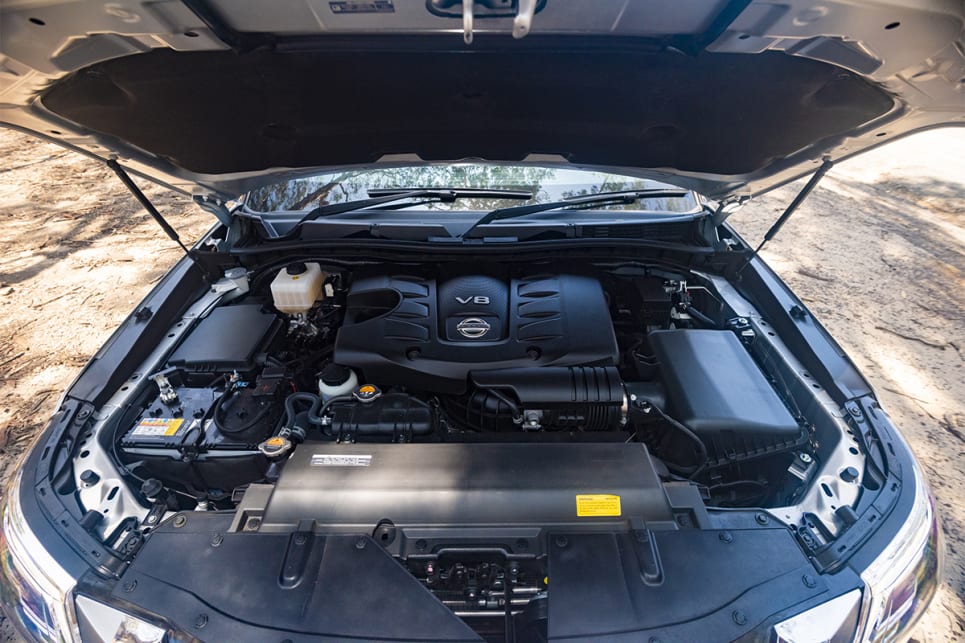 The Patrol’s 5.6-litre petrol V8 makes 298kw/560Nm.
The Patrol’s 5.6-litre petrol V8 makes 298kw/560Nm. 2020 Nissan Patrol/Toyota LandCruiser | engine gallery | Marcus Craft
2020 Nissan Patrol/Toyota LandCruiser | engine gallery | Marcus Craft The Patrol’s 5.6-litre petrol V8 makes 298kw/560Nm.
The Patrol’s 5.6-litre petrol V8 makes 298kw/560Nm.
The Patrol has a bigger capacity 5.6-litre petrol V8, producing more power but less torque at higher revs – 298kw at 5800rpm and 560Nm at 4000rpm – than the LandCruiser. It has a seven-speed automatic transmission.
These are two big punchy engines that make general driving and towing a much more appealing proposition than it would be in a vehicle with an engine that has to work a lot harder than these two.
Towing Specs
Both vehicles had been dealer-fitted with electric brake controllers and we threw towing mirrors on as well to bolster the visibility offered by way of the vehicles’ standard wing mirrors.
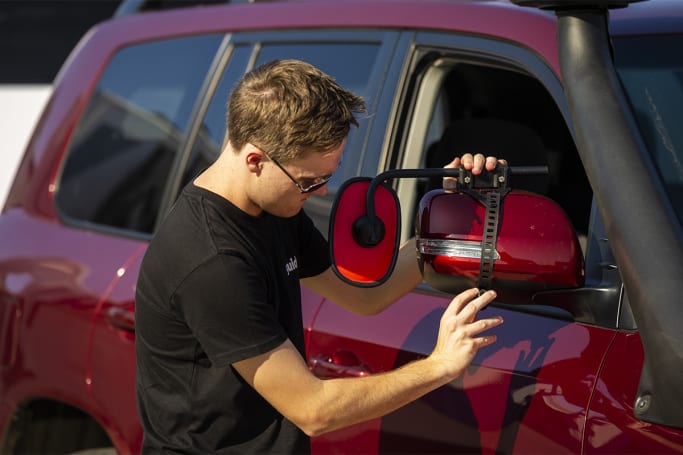 We threw towing mirrors on both cars to bolster the visibility.
We threw towing mirrors on both cars to bolster the visibility.
These wagons are very similar in terms of weights and capacities, except that the Patrol is slightly heavier than the 200 and offers more flexibility in payload and gross combined mass (GCM).
Check out this table for more details:
| Toyota LandCruiser 200 Series GXL 4×4 | Nissan Patrol Ti-L 4×4 | |
| GVM | 3350kg | 3500kg |
| Kerb weight | 2740kg | 2861kg |
| Payload | 610kg | 639kg |
| GCM | 6850kg | 7000kg |
| Unbraked towing capacity | 750kg | 750kg |
| Braked towing capacity | 3500kg | 3500kg |
| Towball down-load limit | 350kg | 350kg |
Towing Review
For the record, both of these big 4WD wagons have a claimed 3.5-tonne braked towing capacity and both were fitted with electric brake controllers (by their manufacturers) and towing mirrors (by us).
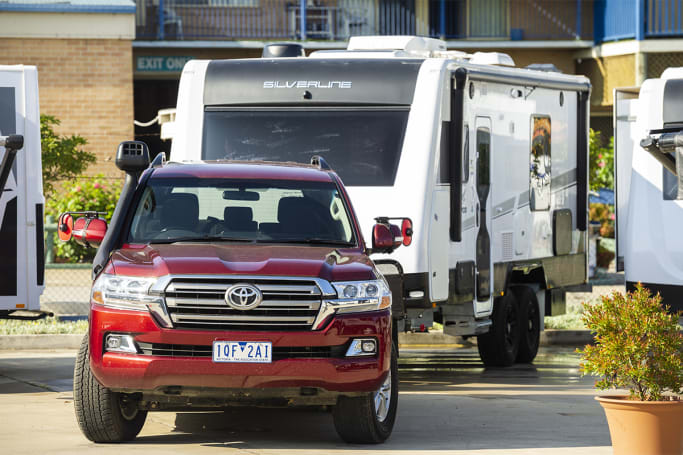 Both the Patrol and LandCruiser had a go at towing the Jayco Silverline Outback.
Both the Patrol and LandCruiser had a go at towing the Jayco Silverline Outback.
The first run of our 140km country road loop – plus a few kms of mostly well-maintained dirt track – involved the laden 200 Series, and the unladen Patrol. We towed a Jayco Silverline Outback, courtesy of our mates at Jayco Nowra, and here are a few key facts about the caravan:
Jayco Silverline Outback
| Travel length | 8065mm |
| Width | 2470mm (incl awning) |
| Height | 3055mm |
| Tare weight | 2650kg |
| Cost (incl govt charges) | $87,103 |
Yep, it’s a pretty big van, but I was confident these two would be comfortable towing it.
The caravan is well within the LandCruiser’s 3.5 tonne braked towing capacity and we’re also well under the total maximum weight permissible for this vehicle and caravan – the gross combination mass, or GCM – which is 6850kg. The LandCruiser weighs 2740kg and has a GVM of 3350kg.
Keep in mind that, when you’re towing, numerous other weight-related factors come into play; how many passengers you have, how much gear you have, what aftermarket equipment your vehicle has on it and more. But if you read our yarns on vehicle weights and keep well under all of the recommended weight limits, you’ll stay safe and on the right side of the law.
I’ll cover the Patrol’s weights later on.
It’s a pretty big van, but I was confident these two would be comfortable towing it.
A comfortable driver is a safe towing driver and it’s easy to get comfortable in the 200 Series: steering is reach-and-rake adjustable, the seat is manually adjusted, and so you can really dial-in your position and get set.
Towing can be tiring – it’s situational awareness turned up to 11, your head always has to be on a swivel, you need to be aware of everything that’s going on with the vehicle and whatever you’re towing behind, whether that’s a trailer or a boat or a caravan.
Getting comfortable and set for the long haul is a simple thing to do in the LandCruiser because you can get your position right, be ready, be comfortable and then you can do some safe towing.
On the open road, you never really feel the full burden of the almost-2700kg load.
The V8 is a growling, lively unit and works well with the six-speed auto, which is quite cluey, always finding the sweet spot on ever-changing gradients. Every now and again it holds on for a little bit too long or down-shifts a bit too hard, but otherwise it delivers a nice sustained torque and it gets that to the road and that gives the driver plenty of confidence.
The suspension – double wishbone, coil springs, gas dampers and anti-roll bar at the front, and four-link coil rear suspension with Panhard rod, gas dampers, and anti-roll bar – takes the edges off pretty much everything, except more severe patches of chopped up gravel here and there, but overall it’s a smooth, stable ride and that also goes towards helping the driver – me – feel more confident and able to enjoy the experience.
The good news continued off-road because even on rutted dirt and gravel tracks, the 200 Series still felt really settled and it was only ever shaken out of its composure – and even then only ever so slightly – by deeper ruts and harsher corrugations.
The suspension of the LandCruiser takes the edges off pretty much everything.
Back on the open road, you never really feel the full burden of the almost-2700kg load. The Cruiser tends to punch on up short, sharp hills and longer, slower inclines, but it handles the load well.
It always feels like it’s right there in the moment and it’s sorting out the caravan, making sure it’s stable and secure because the Silverline Outback is long and wide – it’s a big lifestyle caravan.
The Cruiser’s manual mode is more of a direct driver experience than auto, to stay on top of things and to move up and down through the transmission, to suit the terrain you’re driving on, but auto is fine and active and in touch with what’s needed.
Getting comfortable and set for the long haul is a simple thing to do in the LandCruiser.
I did notice a definite sponginess to brake-pedal feel. Engine braking is really quite solid and consistent, holding firm the whole way and it’s always going to do its job, it’s always going to kick in when you need it too.
Driver comfort is a huge factor, especially if you plan on doing long hours and big road trips towing, and though the LandCruiser’s cabin is very basic, very simple, it all kind of works: the cloth seats are very supportive and comfortable, fit and finish is impressive and the interior is very roomy.
The touchscreen is too small for my liking and lacks the connectivity, the functionality you’d expect in a vehicle at this price-point, but otherwise the cabin is a perfectly reasonable place in which to spend lots of time. Besides, when you buy a LandCruiser, you’re actually buying into the reputation, the performance, the legend.
The 200 Series still felt really settled on the rough stuff.
Next up was the Patrol. At 2861kg, it is heavier than the Cruiser, but while its maximum towing capacity is the same – 3.5 tonnes – the Patrol’s GCM (7000kg) and GVM (3500kg) are both 150kg more than the Cruiser’s.
The Patrol also has a claimed payload of 639kg, and that’s 29 kilos more than the Cruiser’s.
The Nissan wagon always seems in control of the van.
The first thing you notice in the Patrol is that throaty 5.6-litre V8 petrol growl. Whenever you put the foot down and just motor along, it’s a pleasant backing track.
With an electrically-adjustable driver’s seat, and reach-and-rake power-adjustable steering, it’s supremely easy to get your driving position spot-on in the Patrol. But its steering doesn’t feel quite as precise as the LandCruiser’s. It’s easier to feel confident in the 200 Series from the very start, than it is in the Patrol. But while it’s steering is not quite on-point always, the Patrol’s engine, that big torquey V8 petrol, is very effective and it works so well with the auto, which harnesses everything the engine has to give, and the Patrol gets everything on the road, it gets the van moving and it’s all smooth progress.
Nissan’s firm suspension-feel carries over when the big wagon tows along a dirt track.
The Nissan wagon always seems in control of the van, there were very little fore-and-aft movement and only minor side-to-side jiggling, and it was seldom unsettled, and even then only momentarily.
Inside, the Patrol feels like a premium space; it feels like it fits its price-tag a bit better than the 200 Series. There are soft-touch surfaces, a clearer touchscreen than the Cruiser’s, and while the styling’s a little bit old, there’s a lot to like about this cab. The Patrol’s steering doesn’t feel quite as precise as the LandCruiser’s.
The Patrol’s dash-displayed fuel consumption was 18L/100km, showing a range of 700km for the 140-liter tank, but check out our fill-to-fill figures above (under ‘Fuel Consumption’) for a more accurate indication of what actual fuel consumption will be like. The fuel factor is something every driver of any big 4WD wagon has to consider; your tow vehicle is going to drink a lot, so you have to think about fuel stops.
As for ride and handling, you’d think it’d be like driving a couch along the road, but it’s not. There’s very little body roll around even more pronounced corners – partly due to the Nissan’s Hydraulic Body Motion Control, a system of stabilising hydraulic cylinders cross-linked between wheels – and rather than wallow along on the road, the Patrol, overall, feels like a composed unit, with or without a load behind.
The first thing you notice in the Patrol is that throaty 5.6-liter V8 petrol growl.
However, its suspension is very firm, thumping through sections of country-road bitumen, even though that characteristic may have been less obvious had I not driven the Cruiser and the Patrol back to back.
And the Nissan’s firm suspension-feel carries over when the big wagon tows along a dirt track. You really do cop the bigger lumps and bumps, such as deeper ruts and deeper corrugations, and those sensations drill up through your spine. That’s something which really surprised me about the Patrol because, of the two, I thought it would have more of a plush ride on all surfaces.
Fuel consumption
Towing will always affect fuel economy, but how much fuel did we use? Well, we did the same 140km road loops in each vehicle, laden and unladen, so we’d have an accurate indication of how their fuel consumption compared when they’re towing and not towing.
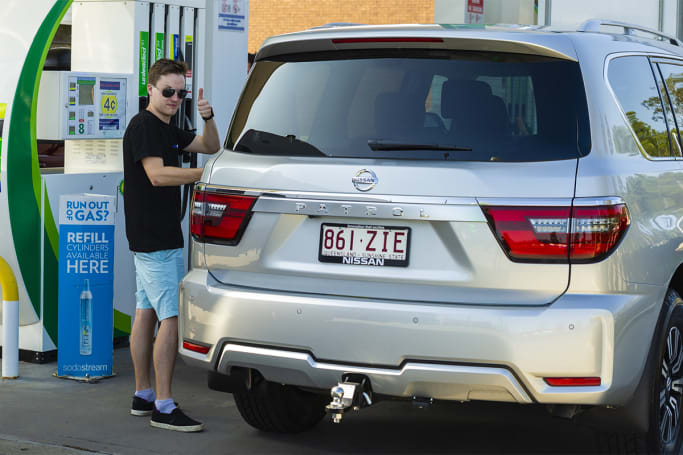 With a Caravan hooked up, the Patrol’s range is likely about 560km.
With a Caravan hooked up, the Patrol’s range is likely about 560km.
Take a moment to check out the differences (below) – they’re only minor, especially in terms of fuel consumption while towing. We drove conservatively on test, rather than trying to maintain the speed limit at all times.
| Toyota LandCruiser 200 Series GXL 4×4 | Nissan Patrol Ti-L 4×4 | |
| Official combined cycle | 9.5L/100km | 14.4L/100km |
| Displayed fuel use on trip computer – not towing | 10.2L/100km | 13.7L/100km |
| Actual fuel use – not towing | 12.6L/100km | 14.3L/100km |
| Displayed fuel use on trip computer – towing | 12.7L/100km | 17L/100km |
| Actual fuel use – towing | 23.5L/100km | 23.7L/100km |
The 200 Series has a 138-litre fuel tank (93L main and 45L sub); the Patrol’s is 140 litres. So, factoring in a 30km safety buffer, the 200’s range while towing would be about 557km (587km, no buffer) on a full tank and the Patrol’s is likely about 560km (590km, no buffer).
The 200’s range while towing would be about 557km.
Ownership
Both vehicles have a five-year, unlimited kilometer warranty.
The LandCruiser’s servicing is scheduled for every six months or 10,000km up to 24 months or 40,000km and costs an average of $300 a time, but that’s for a GXL without the optional KDSS that our test vehicle was equipped with. Check with Toyota.
The Patrol is scheduled for servicing every 10,000km or six months, costing $376, $577, $392, $860, $407 and $624 during its warranty period.
Verdict
It was always going to be a tight contest. There is really very little between the 200 Series and the Patrol; they are both comfortable, have great torquey load-lugging engines and make great towing platforms in their own right.
Even fuel consumption was very even on the towing loop and that was a surprise.
But, for me, the LandCruiser, edges out the Patrol. In this instance, reliability wins out over any perceived refinement advantage the Patrol may have. I’m talking about “reliability” in terms of being more reliable as a tightly controlled tow vehicle, and its all-around confidence-inspiring performance makes the 200 my choice for the better tow vehicle this time around, over what is a feature-packed and plush Patrol.



